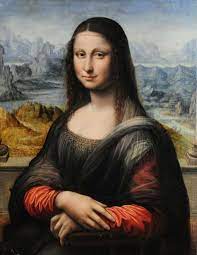
The Mona Lisa, also known as La Gioconda, has been perhaps the most famous painting in the world since its creation in 1503 by Leonardo da Vinci. The painting is so well-known, many people think they know everything there is to know about it.
In fact, there are several fun facts surrounding the Mona Lisa that are not widely known but are absolutely fascinating! Read on to learn more about the famous painting that hangs in the Louvre in Paris today!
1) The history behind the painting
The history behind the painting includes a few different stories. One of the most popular and well known, is that Leonardo Da Vinci created the painting as a gift for his friend and patron, Francesco del Giocondo.
Another popular story states that Del Giocondo's wife, Lisa Gherardini-Gioconda, who was also known as La Joconde in France and La Giocolata in Italy, either commissioned or posed for the painting herself.
A third possible history is that after having it stolen from him, Duke Ludovico Sforza hired Leonardo to paint an image of his mistress so he could have something to remember her by.
In this version, the woman in the painting is not Lisa but rather one of Duke Sforza’s other mistresses, Cecilia Gallerani. And finally there is a fourth version which claims that Leonardo completed the work for himself because he had fallen madly in love with his own masterpiece.
2) The mystery of the subject's identity
The identity of the subject in Leonardo da Vinci's masterpiece, the Mona Lisa, has been a mystery for centuries.
There are many theories about who the subject could be; some say it's just an idealized version of da Vinci himself, while others believe it to be his mother. But one thing that most art historians agree on is that the subject must have posed for Leonardo at some point because there are no other paintings by his contemporaries that depict such a realistic human form.
3) The technical mastery involved in its creation
The technical mastery involved in its creation makes it one of the most famous paintings in history. The reason for its fame was due in large part to Leonardo Da Vinci's skill as a painter.
He was such a talented artist that he could use his skills with oil paint, and also create depth and perspective on a flat surface. This painting was done using oil paint on a canvas.
It is not entirely certain what year it was painted or how long Leonardo spent painting it. It may have taken him four years to complete this masterpiece.
4) The way the painting captures a sense of movement
The way the painting captures a sense of movement and the sense of depth with both the foreground and background as well as the expression on her face makes it famous. The woman in the painting was likely Lisa del Giocondo, who was a Florentine noblewoman in Leonardo's time.
It is known that Leonardo never married, so he may have been infatuated with this woman and that could be why he painted her. He also did sketches of women from his circle of friends and family, some which were just sketches with no color.
This painting was started in 1503 but Leonardo did not complete it until 1517. The reason for the difference in date is unknown, but experts speculate that he might not have had the right materials or didn't feel satisfied with his work up to that point.
5) The play of light and shadow across the composition
The play of light and shadow across the composition gives the painting a sense of mystery and eeriness. The use of light and shadow can also be seen in other paintings, such as by Rembrandt, who often uses it to create an eerie atmosphere.
There is speculation that this effect was created by Leonardo’s obsession with optics, which he studied with his father when he was a child.
The careful study of optics would have been important for Leonardo when painting portraits and sketches because they required perspective and proportions.
The mastery of light on canvas can be explained by Leonardo’s observations on how objects cast shadows or how one object blocks another from the sunlight's rays.
6) The painting's emotional power
The painting's emotional power is due to Leonardo's mastery of composition and use of perspective, which provides a sense of depth and three-dimensionality. The woman's hands are positioned in an ambiguous way, with one hand resting on her lap in an open palm gesture and the other hidden.
This adds to the intrigue as we can't see what she is actually holding or if she has a hidden message for us.
7) The way it has been interpreted by artists and critics over time
The way it has been interpreted by artists and critics over time has helped make it one of the most famous paintings in history. Even though there are many interpretations of what the painting might represent, one thing that is for certain is that it has become a part of our collective imagination.
It is always mentioned in popular culture and references to it have been made by other artists including Salvador Dali who famously painted his interpretation of the original.
8) The public's fascination with the painting's theft and subsequent recovery
The public's fascination with the painting's theft and subsequent recovery has contributed to the Mona Lisa's fame. In 1911, an Italian painter named Vincenzo Peruggia stole the painting from The Louvre in Paris and smuggled it back to Italy.
He later tried to sell it back to the museum but was recognized and arrested. Once returned, the painting was exhibited in Italy as a celebration of its return before finally being returned to The Louvre in 1913 .
9) The painting's status as an icon of Western culture
The painting's status as an icon of Western culture has been attributed to many factors. The painting's popularity, in part, may be because it was Leonardo da Vinci's last work and can be seen as a symbol of both his genius and the Renaissance period.
Many art historians regard the Mona Lisa not just as one of the best paintings ever made, but also as one of the most important works of art in history.
10) The Mona Lisa's enduring appeal
The Mona Lisa's enduring appeal can be attributed to many things, but it may also have something to do with its ability to transcend different cultures and languages. The iconic image of this painting has been reproduced in countless forms, from posters to jewelry.
It's been used in movies and on TV shows, and even as a video game character. And yet the Mona Lisa remains just as recognizable today as she was 500 years ago when she was painted by Leonardo da Vinci.




















